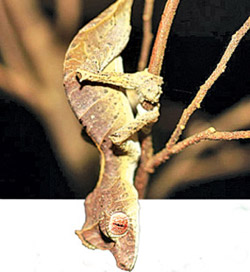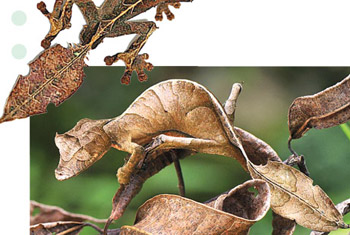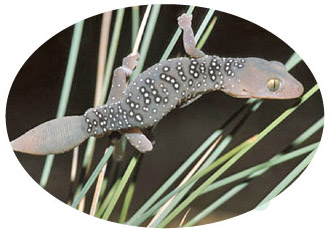|
[Nature trail]
Geckos 11:
A unique trio
Were you surprised to learn from last week's article on Nature trail
that the familiar little gecko which runs all over the walls in our
homes is not alone in the animal kingdom as we thought? This little
creature, we hardly take any notice of certainly seems to have some
bright and sprightly cousins who keep the family in the limelight.As
promised last week, we introduce you to some more fascinating cousins of
our inconspicuous house gecko. They are the Jewelled gecko, the Electric
blue gecko and the Leaf-tailed gecko. A picture gallery of some more
colourful geckos is also given.
**********
Leaf tailed geckos
|

Spear point leaf-tailed gecko. |
The leaf- tailed geckos (Uroplatus )which are also called flat tailed
geckos are found only on the African island of Madagascar and on a
number of the little islands that surround it. There are eight different
species of leaf-tailed geckos, all of which are endemic to the island.
Some of these species are the Spear point leaf-tailed gecko, the
Henkel's leaf tailed gecko, Satanic leaf-tailed gecko and the Mossy
leaf-tailed gecko. They are found in the tropical forests of Madagascar
where they are either found stuck vertically to the tree trunks or
resting amongst the twigs. When the leaf-tailed geckos are in a tree, it
is very hard to see them because they are camouflaged.Leaf tailed geckos
are also found in Australia.
 |
Named after their broad, flat leaf-like tail, which extends out
between this lizard's hind legs, these geckos are brown or green in
colour and their skin is usually marked in such a way that it resembles
tree bark. The excellent camouflage makes it difficult for predators
such as birds of prey, which includes owls and eagles, to spot them.
Apart from these birds of prey the leaf- tailed geckos have to protect
themselves from rats and snakes which are the most common predators in
their native environment.
Very little is really known about the reproductive behaviours of this
reptile. It is thought that the female lays two to four eggs and
probably has little to do with her offspring after laying her eggs in a
safe place.
Today, leaf-tailed geckos are animals that are thought to be under
threat in the wild, something which has caused primarily by
deforestation across their native island of Madagascar. All species of
leaf-tailed gecko are under threat across the island.
**********

Jewelled geckos
The Jewelled geckos, (Naultinus gemmeus,) are a species of geckos
endemic to the South Island of New Zealand. Researchers have found that
there are two main subgroups of jewelled geckos: those living in Otago
and those living in Canterbury. There are some differences in these two
sub species and the obvious difference is that some of the males of the
Canterbury geckos are grey or brown with yellow, purple and white
markings;
 whereas
all Otago geckos are green with yellow and white markings. However, male
jewelled geckos in Canterbury are considered unique in that they are
usually brown, grey and white. These colour splotches or stripes,
resembling jewels to some, are what give the geckos their name. whereas
all Otago geckos are green with yellow and white markings. However, male
jewelled geckos in Canterbury are considered unique in that they are
usually brown, grey and white. These colour splotches or stripes,
resembling jewels to some, are what give the geckos their name.
The average jewelled gecko is 160 mm long, including its tail that
accounts for almost half of its overall length.These geckos are recorded
to have hazel eyes and vertical slit pupils. They also have clawed toes
that are adapted to climbing the trees and bushes they live in. Unlike
the leaf-tailed gecko and some of the other members in the family these
jewelled geckos do not have the ability to change colour. In contrast to
most reptiles which are silent, the jewelled geckos use "chirping and
chattering communication calls and a loud croak to signal alarm or
distress." These and other geckos found in New Zealand are highly
protected and it is illegal to capture or disturb them..
*********
Electric blue geckos
First discovered by biologist William in the 1950s, these geckos are
commonly known as William's Dwarf Geckos or the Electric Blue Geckos (Lygodactylus
 williamsi).
They are found in the Kimboza Forest in eastern Tanzania. This tropical
forest habitat, is believed to be rapidly shrinking due to
deforestation, posing a threat not only to these geckos, but also to
most other animals found here. williamsi).
They are found in the Kimboza Forest in eastern Tanzania. This tropical
forest habitat, is believed to be rapidly shrinking due to
deforestation, posing a threat not only to these geckos, but also to
most other animals found here.
The males are bright blue with heavy black throat stripes. The
females however vary in colour and range from brown or bronze to bright
green.They have little no black on their throat and so they can easily
be confused with juvenile or socially suppressed males that are also
green, sometimes with a blueish cast.
Both male and female electric blue geckos have orange coloured
undersides. The colours of these geckos are said to vary according to
mood and temperature. Males may range from black or grey to brilliant
electric blue and females may range from dark brown to brilliant green
with turquoise highlights. Adult snout-vent length is 5 to 8 cm.
These geckos feed on small insects and drink water from leaves. They
are also fond of nectar.
A diurnal species, these tiny geckos are bold, active, social
creatures with the males being territorial. Some of the gestures these
geckos resort to when socialising with other geckos include lateral
flattening, puffing out of the throat patch, head shaking and head
bobbing, and tail-wagging. Males court females with lateral flattening,
puffing out of the throat pouch, and head bobbing. The female lays a
clutch of two pea-sized white, hard-shelled eggs which are glued to a
surface in a secure, hidden location. Eggs hatch in 60 to 90 days.
These small geckos are remarkable for their virtually fearless
nature, and can be tamed quickly so they are kept as exotic pets.
Facts and pix: Internet |

